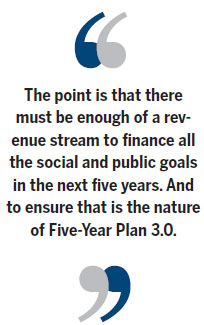Five-Year Plan 3.0 puts society first
Updated: 2015-11-06 07:38
By Ed Zhang(China Daily Europe)
|
|||||||||||
Growth target debate has overshadowed new approach in leadership's latest roadmap
The five-year plan is a unique feature of China's development. It is a phenomenon, to quote Hu Angang, a professor with Tsinghua University's School of Public Policy and Management, that has "survived its teacher" (the former Soviet Union) and has apparently helped produce more wealth.
There has been much difference in the content of the plans, even though the name and time frame have remained the same. It would be interesting to look back on these changes to understand its role in the country.
The Soviet five-year plan used to be like an engineer's plan - to cover virtually every little part of the national economic machine, all the way to the styles and measurements of buttons and zippers, along with each product's universal price, which was not allowed to change from one shop to another. A breach of the central plan could even result in a criminal charge.

The seemingly comprehensive and meticulous planning work did not have the expected result in helping the economy, however, except for concentrating the resources, sometimes excessively, on the development of a few key industries.
A society is not a machine. Trying to turn it into one is against its nature. And it would be silly to make such an effort.
The ultimate form of that kind of planning (let's call it Five-Year Plan 1.0) was the one-child policy, which has been in place for more than 30 years and will be abolished at the beginning of the 13th Five-Year Plan (2016-20), as Chinese leaders recently decided.
In the late 1970s, when China was only beginning to open up, the first foreign journalists to come to the country used to describe it as a country of "blue ants", people all clad in blue uniforms. They were not reporting about a mass style, but about an economy's lack of responsiveness to society's demand.
With the launch of the market-oriented reform came Five-Year Plan 2.0, in which all state-fixed prices and most product targets were abandoned. This plan became more like a strategy paper, containing a few overall targets, such as those for GDP and national incomes, and for new railways and housing.
That kind of planning obviously worked better to help China generate the best development it has seen in the past 700 years, to grow from a near-failure of state into one of the strongest economic powerhouses in the world.

Five-Year Plan 2.0 was more useful as a statement of the macroeconomic policies in current use. It would present businesspeople in China, whether Chinese nationals or foreign investors, an integrated report about the opportunities likely to emerge in this large and rapidly changing economy, including the opportunities that might be difficult to spot from an individual perspective.
Reading President Xi Jinping's "explanatory comments" on the newly proposed 13th Five-Year Plan, one gets the impression he is determined in wanting to keep the nation's GDP growing at no lower than 6.5 percent a year.
The following debate as to whether China can achieve such an ambitious goal has overshadowed a major difference of the new five-year plan from its predecessors.
It may represent an evolving model for Five-Year Plan 3.0. It actually features more targets in social development and public services than economic ones. But just as in the planning of economic development, the preferred macro-level changes are pinned down to a selected number of micro-level targets, such as the number of people to be resettled in the cities and the social security terms they should enjoy.
This way, economic development is more closely connected with the need from social and public programs. Whether a fixed amount of GDP growth must be achieved is therefore beside the point.
The point is that there must be enough of a revenue stream to finance all the social and public goals in the next five years. And to ensure that is the nature of Five-Year Plan 3.0.
The author is editor-at-large of China Daily. Contact the writer at edzhang@chinadaily.com.cn
(China Daily European Weekly 11/06/2015 page12)
Today's Top News
UK unveils new spying powers, raising privacy fears
UN chief commends efforts by China, France to push for climate pact
China and Europe to jointly fund scientific research and innovation
Merkel calls for European solution to refugee crisis
China, France made progress in nuclear energy cooperation
More than 100 UK investment projects revealed
Hollande highlights green growth during visit
Tougher controls leave migrants stuck in Austria
Hot Topics
Lunar probe , China growth forecasts, Emission rules get tougher, China seen through 'colored lens', International board,
Editor's Picks

|

|

|

|

|

|






